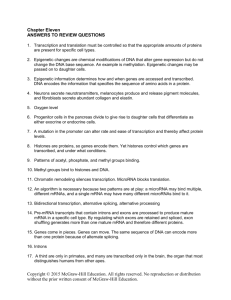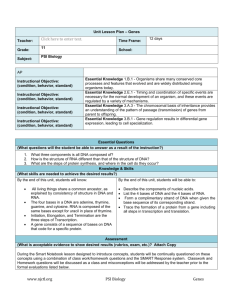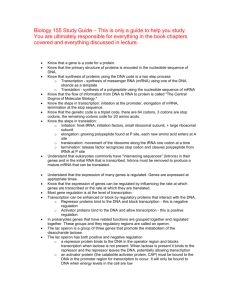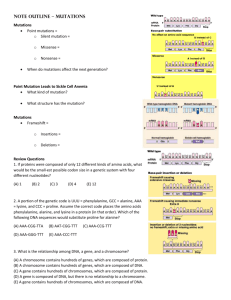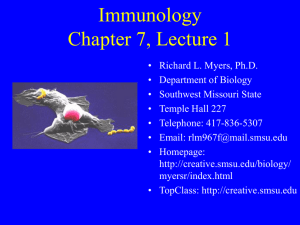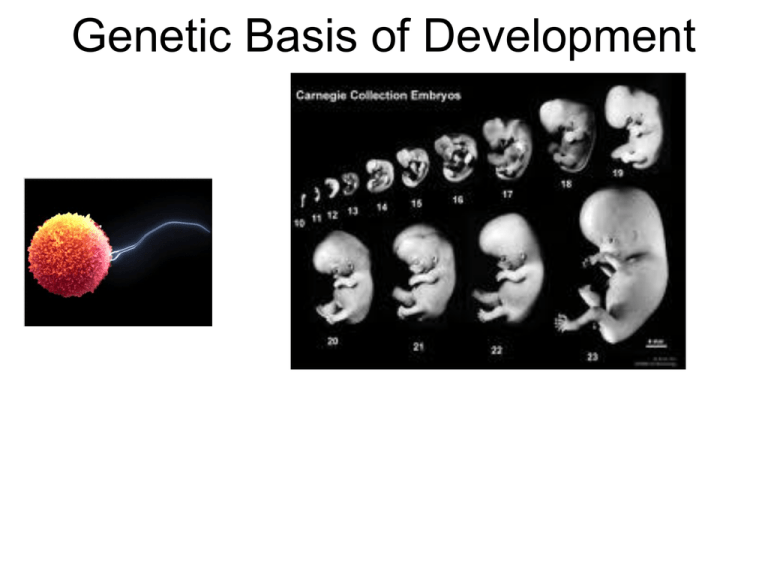
Genetic Basis of Development
Eukaryotic Genome Organization
Prokaryotic cell
vs
Eukaryotic cell
In eukaryotic cells, most DNA
is nuclear & organized as
follows:
dsDNA (helix) is wrapped
around histone proteins which
coil together to form
nucleosomes
Heterochromatin – sections
of DNA where nucleosomes
are tightly packed together;
little gene expression
Euchromatin – sections of
DNA where nucleosomes are
more loosely packed; high
gene expression
Transcription Factors
Within eukaryotes, genes are expressed in a
tissue-specific manner through transcription
factors
Activators - bind DNA and cause protein-mediated
bending of DNA → transcription occurs
Repressors – bind DNA and prevent transcription
COMBINATION EXPRESSED AT A PARTICULAR
TIME DETERMINES HOW MUCH PROTEIN IS
PRODUCED
Prok vs. Euk regulation of gene
expression
Prokaryotes (i.e. bacteria) use operons to regulate
gene expression
Eukaryotes use transcription factors
Both use regulatory sequences
In prok, the regulatory gene makes repressor
In euk, the regulatory sequences are bound by various
transcription factors
Cell Differentiation
Cell decides to become a particular type of cell
Cell expresses a particular set of genes that forces it to
develop into a particular cell
These tissue-specific genes are located on
euchromatin (expressed/loosely wound portion of DNA)
within the given cell
So how does a cell decide?
Cells of zygote undergo rounds of mitosis to form
stem cells (cells that are not yet differentiated and
have the potential to develop into any type of cell)
Based on their location in developing zygote, stem
cells produce particular proteins (i.e. transcription
factors) which tell the surrounding cells what to
become
Transcription Factor “Cascade”
Transcription factor binds with DNA inside nucleus
Turns on the expression of particular genes
Results in expression of proteins that “cascade” or
spread to neighboring cells
Causes those cells in the area to develop into a specific
tissue
Embryonic induction – cell will influence (induce)
surrounding cells into developing into particular
tissues/organs
Example: SRY gene
Y chromosome contains SRY (sex determining
region on Y chromosome) gene
In males, SRY gene produces protein causing
differential development of sex organs etc
Example: Cave Fish
“eyeless cave fish” given
lens of normal fish → cave
fish develops eye sight
Eyeless cave fish lens
transplanted into normal fish
→ nothing happens
Thus there is some factor
inside the normal lens that
causes it to “induce”
surrounding cells to develop
into vision-capable cells
Apoptosis During Development
Apoptosis – programmed cell death; important
during embryonic development
Example:
Tissues between fingers and toes dies off in utero
(called morphogenesis)
microRNA
Single stranded RNA (ssRNA) found in all
organisms
MicroRNA functions to disrupt mRNA and prevent
it from making proteins
Example:
Drosophila mutants without microRNA: the grim, hid,
and reaper genes (responsible for apoptosis) are
overexpressed → significant uptick in apoptosis and
embroyic death
Thus microRNA functions to repress the apoptotic
genes in particular tissues
Homeotic Genes
Genes found in many organisms that determine
where body parts will go in the organism
Ex: HOX genes in drosophila
Mutation in ubx – two thoraxes develop
Mutation in antp – leg grow from head

